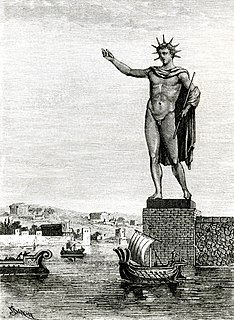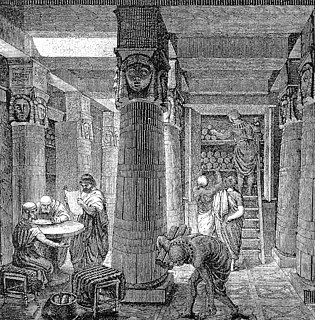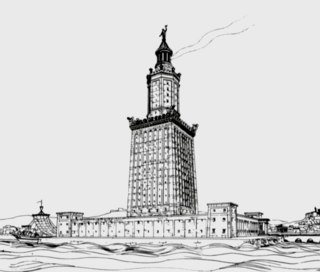 W
WThe Cadmea, or Cadmeia, was the citadel of ancient Thebes, Greece, which was named after Cadmus, the legendary founder of Thebes. The area is thought to have been settled since at least the early Bronze Age, although the history of settlement can only be reliably dated from the late Mycenaean period.
 W
WThe Colossus of Rhodes was a statue of the Greek sun-god Helios, erected in the city of Rhodes, on the Greek island of the same name, by Chares of Lindos in 280 BC. One of the Seven Wonders of the Ancient World, it was constructed to celebrate its successful defense against Demetrius Poliorcetes, who had besieged it for a year with a large army and navy. According to most contemporary descriptions, the Colossus stood approximately 70 cubits, or 33 metres high— approximately two thirds the height of the modern Statue of Liberty from feet to crown—making it the tallest statue in the ancient world. It collapsed during the earthquake of 226 BC, although parts of it were preserved. In accordance with a certain oracle, the Rhodians did not build it again. John Malalas wrote that Hadrian in his reign reerected the Colossus, but he was wrong. According to Suda, the Rhodians were called Colossaeans (Κολοσσαεῖς), because they erected the statue on the island.
 W
WDendera Temple complex is located about 2.5 kilometres (1.6 mi) south-east of Dendera, Egypt. It is one of the best-preserved temple complexes in Egypt. The area was used as the sixth nome of Upper Egypt, south of Abydos.
 W
WIndo-Corinthian capitals are capitals crowning columns or pilasters, which can be found in the northwestern Indian subcontinent, and usually combine Hellenistic and Indian elements. These capitals are typically dated to the first centuries of the Common Era, and constitute an important aspect of Greco-Buddhist art.
 W
WThe Great Library of Alexandria in Alexandria, Egypt, was one of the largest and most significant libraries of the ancient world. The Library was part of a larger research institution called the Mouseion, which was dedicated to the Muses, the nine goddesses of the arts. The idea of a universal library in Alexandria may have been proposed by Demetrius of Phalerum, an exiled Athenian statesman living in Alexandria, to Ptolemy I Soter, who may have established plans for the Library, but the Library itself was probably not built until the reign of his son Ptolemy II Philadelphus. The Library quickly acquired many papyrus scrolls, due largely to the Ptolemaic kings' aggressive and well-funded policies for procuring texts. It is unknown precisely how many such scrolls were housed at any given time, but estimates range from 40,000 to 400,000 at its height.
 W
WThe Library of Pergamum in Pergamum, Turkey, was one of the most important libraries in the ancient world.
 W
WThe Lighthouse of Alexandria, sometimes called the Pharos of Alexandria, was a lighthouse built by the Ptolemaic Kingdom, during the reign of Ptolemy II Philadelphus, which has been estimated to be at least 100 metres (330 ft) in overall height. One of the Seven Wonders of the Ancient World, for many centuries it was one of the tallest man-made structures in the world.
 W
WMancınık Castle is a Hellenistic castle ruin in Mersin Province, Turkey.
 W
WThe Pergamon Altar is a monumental construction built during the reign of king Eumenes II in the first half of the 2nd century BC on one of the terraces of the acropolis of the ancient Greek city of Pergamon in Asia Minor.
 W
WA serapeum is a temple or other religious institution dedicated to the syncretic Greco-Egyptian deity Serapis, who combined aspects of Osiris and Apis in a humanized form that was accepted by the Ptolemaic Greeks of Alexandria. There were several such religious centers, each of which was a serapeion or, in its Latinized form, a serapeum. An Egyptian name for the temple of Osiris-Apis was Pr-Wsỉr-Ḥp "House of Osiris-Apis".
 W
WThe Serapeum of Alexandria in the Ptolemaic Kingdom was an ancient Greek temple built by Ptolemy III Euergetes and dedicated to Serapis, who was made the protector of Alexandria. There are also signs of Harpocrates. It has been referred to as the daughter of the Library of Alexandria. The site has been heavily plundered.
 W
WThe Stoa of Attalos was a stoa in the Agora of Athens, Greece. It was built by and named after King Attalos II of Pergamon, who ruled between 159 BC and 138 BC. The current building was reconstructed in 1952–1956 by the American School of Classical Studies at Athens and currently houses the Museum of the Ancient Agora.
 W
WThe Stoa of Eumenes was a Hellenistic colonnade built on the South slope of the Acropolis, Athens and which lay between the Theater of Dionysus and the Odeon of Herodes Atticus The gallery was donated to the city of Athens by the king of Pergamon, Eumenes II, around 160 BC. Vitruvius makes reference to the building when speaking about the purpose of stoai erected near theatres that served as a refuge for the spectators in inclement weather conditions or as stores for theatre props.
 W
WThe Temple of Edfu is an Egyptian temple located on the west bank of the Nile in Edfu, Upper Egypt. The city was known in the Hellenistic period in Koinē Greek: Ἀπόλλωνος πόλις and in Latin as Apollonopolis Magna, after the chief god Horus, who was identified as Apollo under the interpretatio graeca. It is one of the best preserved shrines in Egypt. The temple was built in the Ptolemaic Kingdom between 237 and 57 BC. The inscriptions on its walls provide important information on language, myth and religion during the Hellenistic period in Egypt. In particular, the Temple's inscribed building texts "provide details [both] of its construction, and also preserve information about the mythical interpretation of this and all other temples as the Island of Creation." There are also "important scenes and inscriptions of the Sacred Drama which related the age-old conflict between Horus and Seth." They are translated by the German Edfu-Project.
 W
WThe Temple of Kom Ombo is an unusual double temple in the town of Kom Ombo in Aswan Governorate, Upper Egypt. It was constructed during the Ptolemaic dynasty, 180–47 BC. Some additions to it were later made during the Roman period.
 W
WThe Tower of the Winds or the Horologion of Andronikos Kyrrhestes is an octagonal Pentelic marble clocktower in the Roman Agora in Athens that functioned as a horologion or "timepiece". It is considered the world's first meteorological station. Unofficially, the monument is also called Aerides, which means Winds. The structure features a combination of sundials, a water clock, and a wind vane. It was supposedly built by Andronicus of Cyrrhus around 50 BC, but according to other sources, might have been constructed in the 2nd century BC before the rest of the forum. In summer of 2014, the Athens Ephorate of Antiquities began cleaning and conserving the structure; restoration work was completed in August 2016.
 W
WUzuncaburç is an archaeological site in Mersin Province, Turkey, containing the remnants of the ancient city of Diokaisareia or Diocaesarea.